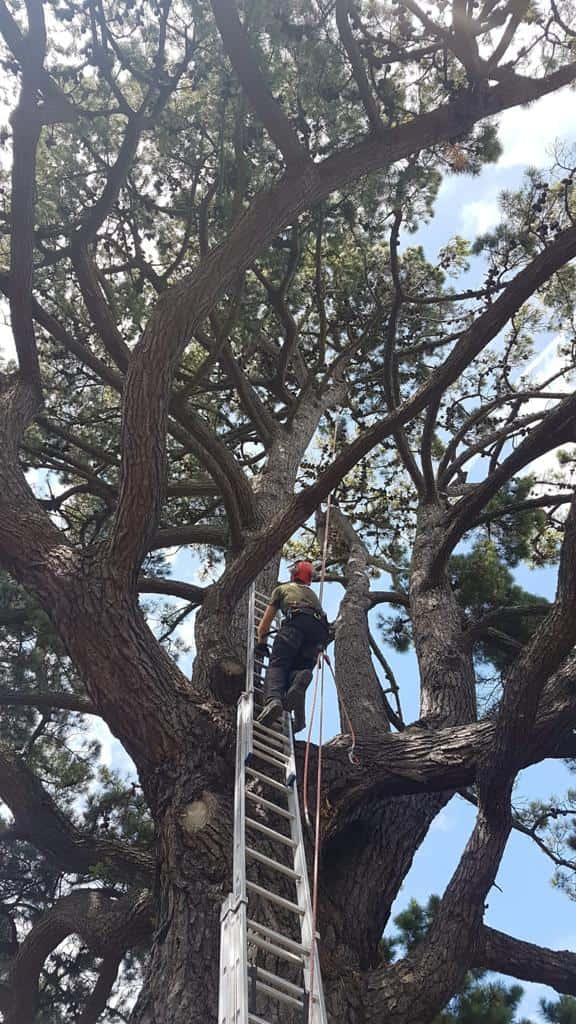Tree felling is a complex task that requires skill, experience, and a clear understanding of safety measures. Unfortunately, when tree felling is not done correctly, the consequences can be severe, from property damage to personal injury. At LM Tree Surgery Southsea, based in Southsea, Hampshire, we have seen the results of tree felling gone wrong and understand the importance of getting it right. In this blog post, we’ll explore some common real-life mistakes made during tree felling and offer guidance on how to avoid them.
1. Incorrect Directional Cuts
One of the most frequent mistakes in tree felling is making incorrect directional cuts, which can cause the tree to fall in an unintended direction. If a tree falls the wrong way, it can cause serious damage to nearby structures, vehicles, or even people.
- The mistake: Failing to assess the tree’s natural lean or miscalculating the direction of the fall can result in the tree collapsing in a dangerous area.
- How to avoid it: Professional tree surgeons use precise calculations to create the correct notch and back cuts, ensuring the tree falls safely. Always consult experienced professionals to avoid this risk.
2. Ignoring Nearby Hazards
Failing to account for nearby hazards is another common error in tree felling. Power lines, buildings, roads, and even other trees can be affected if the felling process is not carefully planned.
- The mistake: Overlooking obstacles such as utility lines or failing to recognise how a tree could affect neighbouring trees during the felling process.
- How to avoid it: Before starting any tree felling, it’s critical to conduct a thorough site assessment. This should include identifying all hazards and planning how to avoid them. A professional tree surgeon can develop a plan to safely navigate around these obstacles.
3. Underestimating the Size of the Tree
Large trees may seem manageable at first, but once the cutting process begins, their sheer size can quickly become overwhelming. Many amateur attempts at tree felling fail to account for the tree’s weight and the force of its fall.
- The mistake: Assuming a tree is smaller or lighter than it actually is, leading to dangerous surprises during the felling process.
- How to avoid it: Always assess the tree’s height, diameter, and weight before felling. Professionals use specialised equipment to control the tree’s fall and ensure safety.
4. Improper Use of Equipment
Using the wrong tools, or not knowing how to operate equipment correctly, can lead to accidents during tree felling. Chainsaws, in particular, are powerful tools that require training and experience to use safely.
- The mistake: Attempting to fell a tree without the proper equipment or using a chainsaw without adequate training.
- How to avoid it: Ensure that only qualified and experienced individuals handle chainsaws and other tree felling equipment. Professional tree surgeons are trained to use these tools safely and effectively.
5. Not Checking Weather Conditions
Weather plays a significant role in the success of tree felling operations. High winds, heavy rain, or icy conditions can make tree felling far more dangerous than anticipated.
- The mistake: Proceeding with tree felling in unsafe weather conditions, which can cause the tree to fall unpredictably or make the ground slippery and hazardous.
- How to avoid it: Always check the weather forecast before starting any tree felling. If there is any risk of adverse weather, it’s better to postpone the job until conditions improve.
6. Failure to Plan an Escape Route
Even with careful planning, things can go wrong during tree felling. Without a clear escape route, the person cutting the tree can be in danger of being struck or trapped as the tree falls.
- The mistake: Not planning a clear and safe escape route before making the final cut.
- How to avoid it: Tree surgeons always plan two escape routes in opposite directions to ensure they can quickly and safely get out of the way when the tree begins to fall.
7. Attempting to Fell a Tree Alone
Tree felling is never a one-person job. Having a second pair of hands to assist with safety precautions, equipment handling, and monitoring the process is critical for a successful and safe operation.
- The mistake: Attempting to fell a tree without any assistance, increasing the risk of accidents and mistakes.
- How to avoid it: Always have at least one other person present to assist with the tree felling process. Professional tree surgeons typically work in teams to ensure that the job is completed safely and efficiently.
Conclusion
Tree felling is a hazardous task that requires professional expertise to be carried out safely and effectively. When things go wrong, the consequences can be severe, from property damage to personal injury. At LM Tree Surgery Southsea, we have the knowledge, experience, and equipment to carry out tree felling safely, ensuring that all potential risks are managed and avoided.
Call us on: 023 8235 3277
Click here to find out more about LM Tree Surgery Southsea
Click here to complete our contact form and see how we can help with your tree needs.

